This Wednesday, Dave Weaver and I met a group of birders excited by the first birds of spring and hoping for a few more of the birds of winter. They were not disappointed. Before we left to find birds, however, I felt it was important to let people know that it is time to take a moment to write to our federal government. The Department of the Interior is taking comments until March 9 at this website regarding a new plan to open the rest of our coasts (excepting Florida) to oil and gas extraction. Two sites are proposed off of New England. Please compose a message to them to oppose this terrible idea. Mass Audubon’s Advocacy Department is working hard on this one, and you can learn more about it here.

Red-breasted Mergansers – Mike Densmore
With that sobering issue addressed, we headed to the north end of Plum Island. The neighborhoods of Plum Island were bustling with Common Grackles this week, where last week we saw one. The waterbirds were a bit distant this time, with Common Eiders, White-winged Scoters, a few Red-breasted Mergansers, and a small number of Long-tailed Ducks mostly hugging the far shore. We found more mergansers, a Bufflehead, and a couple of Common Goldneyes near the mouth of the basin. A Red-tailed Hawk soared above Salisbury, as did two Turkey Vultures. Small groups of Long-tailed Ducks occasionally raced up and down the river, so we did have a chance for a brief instant of a spectacular bird in flight.
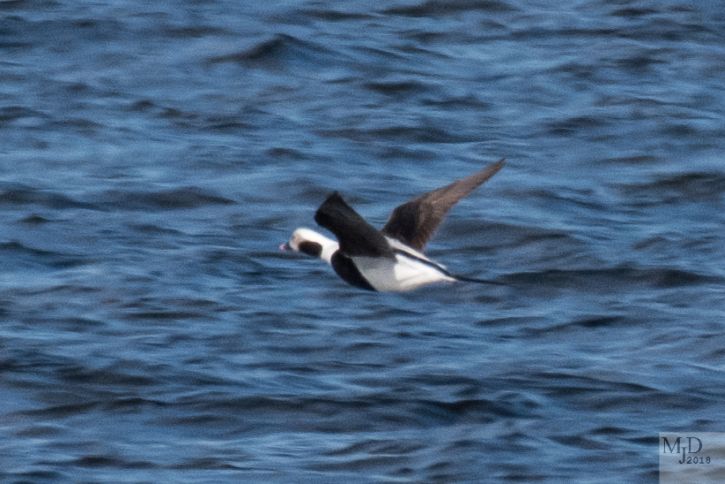
Long-tailed Duck – Mike Densmore
At parking lot #1, we found a very smooth sea. Someday I would like to understand why the Gulf of Maine is so often devoid of waves. This week, it meant that we thought at first there were very few birds at hand. All that was near shore were three female Black Scoters near the first groin to the north, a few White-winged Scoters, two Long-tailed Ducks, and two Horned Grebes. Then when one searched further out with a spotting scope, many more Black Scoters could be seen in tight rafts, most likely engaged in courtship displays. There were more Long-tailed Ducks out there and lots of dark avian objects that were not readily discernible. At one point, I was pretty sure I had a brief look at an alcid, but it dove before I could find field marks. Today, looking at the photos some of our birders sent , we find new birds! We think that the bird below is likely a Thick-billed Murre, but can’t be sure it’s not a Common. It’s possible to find birds in photos that one couldn’t see well enough to identify “by eye” with whatever non-electronic optical equipment you might have. Do what you want with your list, but I like to have an experience of perceiving the diagnostic marks or sounds in the field!

White-winged Scoters – Susan Balser
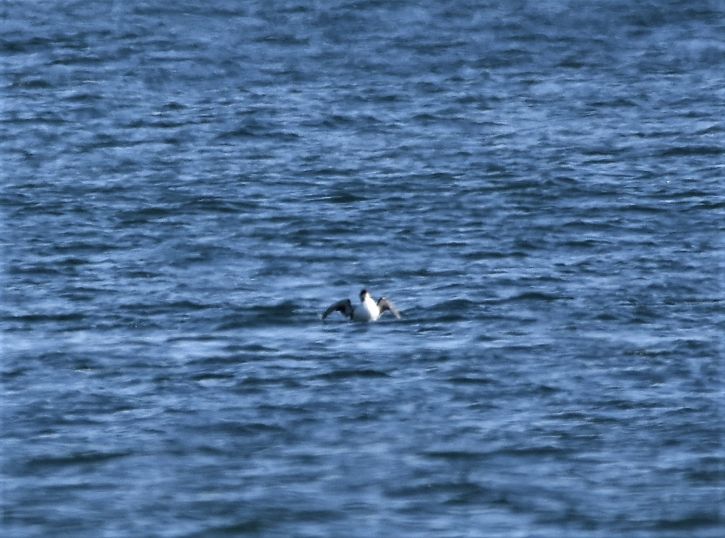
Murre sp. from a great distance – Susan Balser
We had a pretty big group this week, and got completely spread out along the pull-out at the Main Salt Panne. At the south end, we enjoyed watching 38 Gadwalls and one American Wigeon. In the middle of our group, a Snowy Owl was spotted to the northwest on a staddle. At the north end of the group, a FOY Killdeer poked around at the edge of the panne. One gets exercise making sure all the sightings are known and enjoyed up and down the line. What a great way to get the heart rate up!
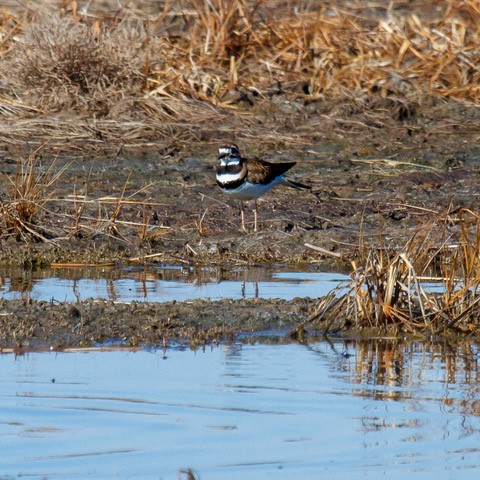
Killdeer – FOY at the Main Panne – Bob Minton
As we continued south through the S-curves, a phenomenon that would be a feature of the day became clear. Groups of three to perhaps eight Song Sparrows were dotted all along the road from the pannes to parking lot #7. The lead van always flushed them, so that none of the other vehicles were able to witness that Wednesday, February 28, 2018, was clearly a big day of migration for Song Sparrows. A couple of Dark-eyed Juncos joined them, but no other sparrow species that we could find. Happily, Tom Wetmore reported the same thing on his website, while other observers saw only a handful the day before.
When you clearly see a particular species migrating, it is a joyful experience. Each and every species has a rhythm that is theirs alone, of all the behaviors that mark their yearly cycle. The rhythm of one might coincide with others on some occasions, and often do. But when we see a species distinctly moving together, we feel a sense of their identity. It elicits a profound wish for their success, for their wellbeing as one of our co-inhabitants. We may dismiss Song Sparrows when “listing” on a Big Day, but this Wednesday, though all we really saw were tiny flocks eating seeds by the road, Song Sparrow was really up to something.
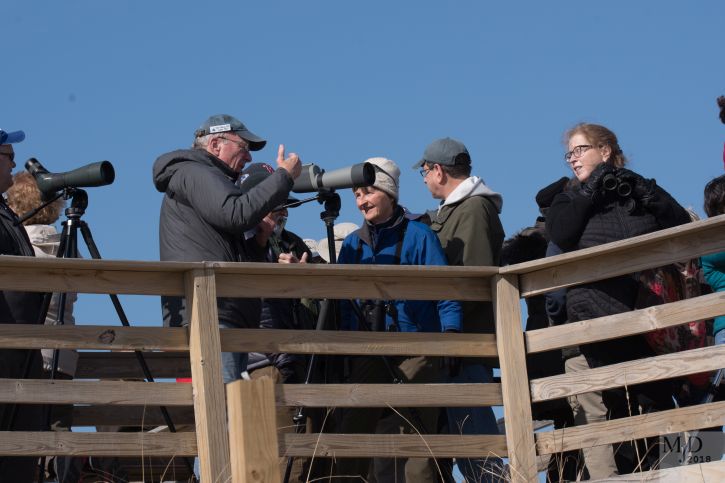
WMB at parking lot #1 platform – Mike Densmore
We hoped for more ducks, especially more wigeons, at Stage Island Pool, which turned out to host only one American Black Duck, so we shoe-horned ourselves into the few spots left at parking lot #7. The fallling tide had exposed a bit of Emerson Rocks, and eiders, grebes, scoters, and a couple of loons all performed their remarkable ability to live happily on frigid waters. With not much time to spare, we headed back north to the dike at Hellcat, to see that Bill Forward Pool is still the favorite spot on the refuge of the Northern Pintail. Perhaps a bird it is notable to mention for its absence this week is Northern Harrier, which we missed last week as well. Rough-legged Hawks have evidently vamoosed, but Snowy Owls continue to delight us. Every week of WMB is different, and it is a fantastic thing to have this practice of camaraderie in pursuit of birds.
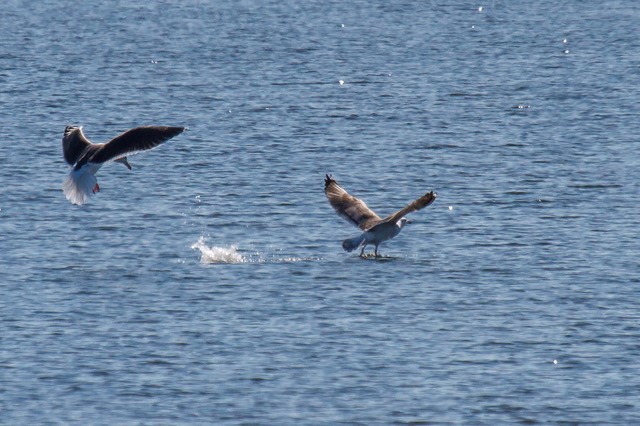
Great Black-backed and Herring Gulls performing agonistic behavior – Bob Minton
Our list:
Canada Goose – common.
Gadwall (38) – Main Panne.
American Wigeon (1) – Main Panne.
American Black Duck – common.
Mallard (~ 6)
Northern Pintail (~ 12) – Bill Forward Pool.
Common Eider (~ 65) – ~40, north end; ~25, parking lot #7 ocean.
White-winged Scoter – common.
Black Scoter – common (mostly parking lot #1 ocean).
Long-tailed Duck (15) – 7, north end; 3, parking lot #1 ocean; 5, parking lot #7 ocean.
Bufflehead (3) – 2, north end; 1, parking lot #7 ocean.
Common Goldeneye (~ 18) – 2, north end; ~14, Plum Island River, w. lot #1; 2, parking lot #7 ocean.
Red-breasted Merganser (~ 19) – north end.
Common Loon (5) – 3, north end; 1, parking lot #1 ocean; 1, parking lot #7 ocean.
Horned Grebe (5) – 3, parking lot #1 ocean; 2, parking lot #7 ocean.
Turkey Vulture (2) – over Salisbury from north end.
Red-tailed Hawk (1) [+ 1, Joppa.]
Killdeer (1) – FOY; north end Main Panne.
Ring-billed Gull
Herring Gull
Great Black-backed Gull
Rock Pigeon
Mourning Dove
Snowy Owl (1) – on staddle northwest of Main Panne.
Downy Woodpecker (1) – S-curves.
American Crow – common.
[Tufted Titmouse (2) – Joppa.]
[Eastern Bluebird (3) – e. Joppa.]
Northern Mockingbird (1) – s. end S-curves.
European Starling
Song Sparrow (~ 100+) – roadside up & down refuge road.
Dark-eyed Junco (2) – S-curves.
[Red-winged Blackbird (~ 12) – PRNWR HQ.]
Common Grackle (~ 17) – north end.
House Finch (1) – north end.
House Sparrow
Addendum:
Joppa is weathering the storm well, though there is some leaking that drives us a bit nuts. At high tide we were nowhere near being flooded, while it is pretty wild out there:
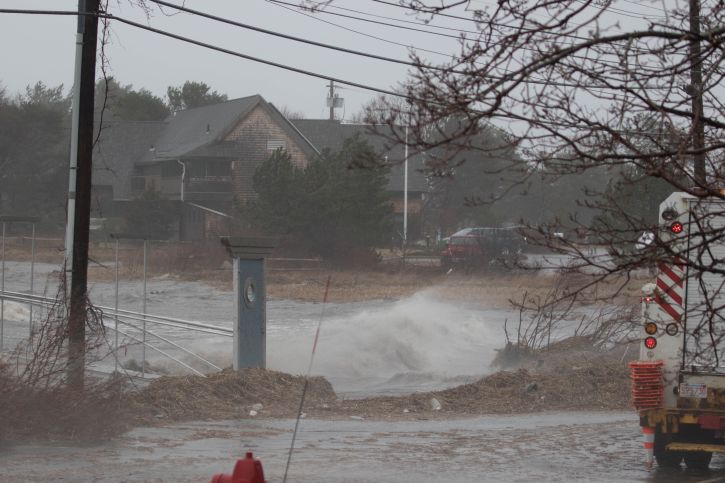
JFEC at high tide with storm surge, 3/2/18 – David Moon

